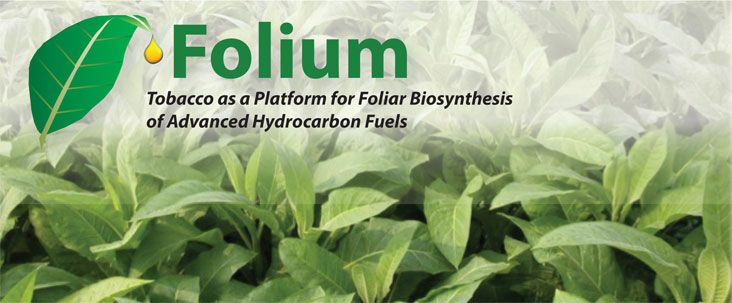Question and Answer
Click on the following questions for more information regarding tobacco-related issues.
1. Why have you chosen tobacco as a crop?2. FOLIUM supporting the tobacco industry?
3. What are the ecological implications of growing GMO tobacco?
4. Are tobacco companies concerned that FOLIUM tobacco will contaminate their tobacco fields?
5. What would this tobacco be used for?
6. Who would be the buyer for this type of tobacco?
7. Will there be possibilities for pilot-testing the tobacco before it is commercialized?
8. Will the tobacco be direct seeded or transplanted?
9. Will there be special climactic conditions required for growing the tobacco?
10. At what stage of growth would the tobacco be harvested to extract the oils?
11. Will the tobacco be uncured or cured in a barn?
12. How will the biofuel product from FOLIUM tobacco be deployed?
1. Why have you chosen tobacco as a crop?
As is outlined in our Background page, tobacco is an outstanding biomass crop with several additional attributes that makes it an excellent system for biofuel production in the FOLIUM project.
Top2. Is FOLIUM supporting the tobacco industry?
FOLIUM is supporting the development and establishment of tobacco as a bioenergy crop, and the generation of an alternative (non-cigarette) market for tobacco.
Top3. What are the ecological implications of growing GMO tobacco?
Tobacco does not outcross with other plants, which is one of several advantages of tobacco as a bioenergy crop. Additionally, FOLIUM uses sterile hybrid tobacco, and most of our transgenes are introduced into the chloroplasts and would not be present in the pollen.
Top4. Are tobacco companies concerned that FOLIUM tobacco will contaminate their tobacco fields?
FOLIUM tobacco plantations will be located at safe distance from fields with conventional tobacco (see also Question 3).
Top5. What would this tobacco be used for?
This new variety of tobacco would be used as a feedstock for extraction of biofuels or biofuel intermediates
Top6. Who would be the buyer for this type of tobacco?
Bio-refineries would purchase FOLIUM tobacco to extract the hydrocarbon-rich effluent (tobacco crude). This crude would then be sold to existing oil refineries for the retail of gasoline, kerosene, and biodiesel. The oil companies can decide whether to process it separately (premium biofuel) or blend it in with their fossil crude for high volume production. Hence, the end buyers in the value chain are oil refineries.
Top7. Will there be possibilities for pilot-testing the tobacco before it is commercialized?
In order to assure commercial viability of FOLIUM growth and processing, it will be necessary to pilot-test every aspect of the process. Thus, there will likely be opportunities for small-scale field plots of FOLIUM tobacco during the process of product development. FOLIUM tobacco seeds or seedlings will initially be distributed to traditional tobacco growers.
Top8. Will the tobacco be direct seeded or transplanted?
The methods for growing FOLIUM tobacco will be the same as those used for conventional tobacco products and will involve transplanting of the plantlets into the field – the methods for which are well established.
Top9. Will there be special climactic conditions required for growing the tobacco?
The genetic modifications of tobacco needed to make hydrocarbons will be introduced into standard tobacco varieties that will not require any unusual growing conditions to maximize yield, other than any of the agronomic improvements that are discovered by FOLIUM researchers.
Top10. At what stage of growth would the tobacco be harvested to extract the oils?
FOLIUM tobacco would be harvested before flowering multiple times during the growing season, as is currently done for other tobacco uses.
Top11. Will the tobacco be uncured or cured in a barn?
It is likely that the plant material will be used green (uncured) for extraction, rather than be dried (cured). The precise extraction methods for biofuels from FOLIUM tobacco will have to be optimized as the research progresses.
Top12. How will the biofuel product from FOLIUM tobacco be deployed?
Although FOLIUM focuses on creating a new variety of tobacco for biofuel feedstock, commercial viability depends on the products entering into well-established industry value chains. The FOLIUM variety of tobacco would scale and benefit from leveraging established tobacco seed suppliers, growers, and crop aggregators in order to penetrate the tobacco-producing market. The value chain then continues with the distribution of FOLIUM tobacco crude to existing oil companies as feedstock for distillation. Hence the technology enters into and leverages well established industry value chains both up and down stream.
Top
Copyright © 2013

